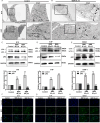A specific super-enhancer actuated by berberine regulates EGFR-mediated RAS-RAF1-MEK1/2-ERK1/2 pathway to induce nasopharyngeal carcinoma autophagy
- PMID: 38943090
- PMCID: PMC11214260
- DOI: 10.1186/s11658-024-00607-4
A specific super-enhancer actuated by berberine regulates EGFR-mediated RAS-RAF1-MEK1/2-ERK1/2 pathway to induce nasopharyngeal carcinoma autophagy
Abstract
Nasopharyngeal carcinoma (NPC), primarily found in the southern region of China, is a malignant tumor known for its highly metastatic characteristics. The high mortality rates caused by the distant metastasis and disease recurrence remain unsolved clinical problems. In clinic, the berberine (BBR) compound has widely been in NPC therapy to decrease metastasis and disease recurrence, and BBR was documented as a main component with multiple anti-NPC effects. However, the mechanism by which BBR inhibits the growth and metastasis of nasopharyngeal carcinoma remains elusive. Herein, we show that BBR effectively inhibits the growth, metastasis, and invasion of NPC via inducing a specific super enhancer (SE). From a mechanistic perspective, the RNA sequencing (RNA-seq) results suggest that the RAS-RAF1-MEK1/2-ERK1/2 signaling pathway, activated by the epidermal growth factor receptor (EGFR), plays a significant role in BBR-induced autophagy in NPC. Blockading of autophagy markedly attenuated the effect of BBR-mediated NPC cell growth and metastasis inhibition. Notably, BBR increased the expression of EGFR by transcription, and knockout of EGFR significantly inhibited BBR-induced microtubule associated protein 1 light chain 3 (LC3)-II increase and p62 inhibition, proposing that EGFR plays a pivotal role in BBR-induced autophagy in NPC. Chromatin immunoprecipitation sequencing (ChIP-seq) results found that a specific SE existed only in NPC cells treated with BBR. This SE knockdown markedly repressed the expression of EGFR and phosphorylated EGFR (EGFR-p) and reversed the inhibition of BBR on NPC proliferation, metastasis, and invasion. Furthermore, BBR-specific SE may trigger autophagy by enhancing EGFR gene transcription, thereby upregulating the RAS-RAF1-MEK1/2-ERK1/2 signaling pathway. In addition, in vivo BBR effectively inhibited NPC cells growth and metastasis, following an increase LC3 and EGFR and a decrease p62. Collectively, this study identifies a novel BBR-special SE and established a new epigenetic paradigm, by which BBR regulates autophagy, inhibits proliferation, metastasis, and invasion. It provides a rationale for BBR application as the treatment regime in NPC therapy in future.
Keywords: Autophagy; BBR; EGFR; Nasopharyngeal carcinoma; Super-enhancer.
© 2024. The Author(s).
Conflict of interest statement
The authors declare no competing financial interests.
Figures








References
MeSH terms
Substances
LinkOut - more resources
Full Text Sources
Research Materials
Miscellaneous

